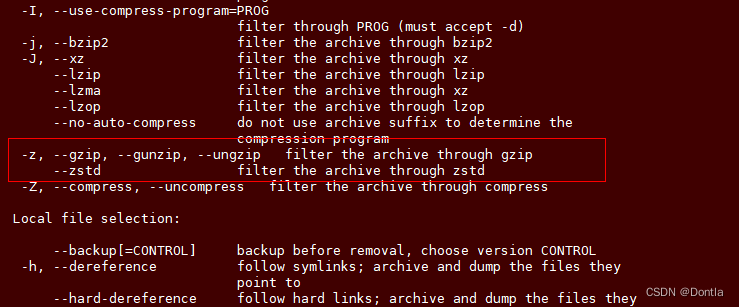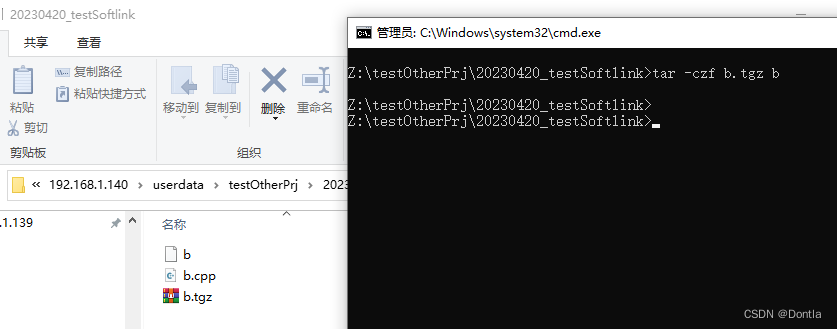linux tar命令解析(压缩解压)(tar指令)(十分之坑,千万不要在windows上解压带有软链接的压缩文件,会把软链接搞没了!软链接丢失、软链接失效)
man 1 tarTAR(1)User CommandsTAR(1)NAMEtar - manual page for tar 1.26SYNOPSIStar [OPTION...] [FILE]..
文章目录
- tar命令简答使用示例
- tar命令使用文档(man 1 tar)
- 示例
- 注意
- 20220926 如何打包指定目录的文件
- 20230129 用解压tgz的命令解压tar还解压不了。。。
- 20230328 自己注意啊,好几次把压缩.tgz文件的后缀写成.tar,到时候别人弄不清的,因为以gzip压缩和解压都要加-z参数的,别人可能不知道,解压的时候不加-z,就解压不出来!
- 20230329 普通压缩包一般用.tgz,但是用docker save -o生成的镜像包就是.tar,这个注意区分开!
- 20230417 十分之坑,千万不要在windows上解压带有软链接的压缩文件,会把软链接搞没了!
- 20231030 如何压缩时对软链接解引用,将实际文件打进压缩包?
- 20231115 解决文件时间相对系统时间超前,导致输出大量警告问题(加-m参数,tar -xzmf不提取文件时间,按解压时间赋予文件时间)
- 2024031 自定义压缩等级,以最快速度压缩
这个命令居然windows控制台也能用!用来解压tgz文件不错@20230228 (要注意不要解压带软链接的,会导致软链接失效!)
除了windows控制台,git的git bash here也支持这个命令:

tar命令简答使用示例
解压tgz:tar xvzf 压缩包
压缩tgz:tar cvzf 压缩包包名.tar 文件1 文件2 文件3…
压缩tgz时排除文件:tar cvzf kyai.tgz kyai/ --exclude=.docker_temp_652316136
解压tgz到某个目录下:tar -xvzf file.tar -C /path/to/directory
tar命令使用文档(man 1 tar)
英文
TAR(1) User Commands TAR(1)
NAME
tar - manual page for tar 1.26
SYNOPSIS
tar [OPTION...] [FILE]...
DESCRIPTION
GNU `tar' saves many files together into a single tape or disk archive, and can restore individual files from the archive.
Note that this manual page contains just very brief description (or more like a list of possible functionality) originally generated by the help2man
utility. The full documentation for tar is maintained as a Texinfo manual. If the info and tar programs are properly installed at your site, the com‐
mand `info tar' should give you access to the complete manual.
EXAMPLES
tar -cf archive.tar foo bar
# Create archive.tar from files foo and bar.
tar -tvf archive.tar
# List all files in archive.tar verbosely.
tar -xf archive.tar
# Extract all files from archive.tar.
DEFAULTS
*This* tar installation defaults to:
--format=gnu -f- -b20 --quoting-style=escape --rmt-command=/sbin/rmt --rsh-command=/usr/bin/rsh
Main operation mode:
-A, --catenate, --concatenate
append tar files to an archive
-c, --create
create a new archive
-d, --diff, --compare
find differences between archive and file system
--delete
delete from the archive (not on mag tapes!)
-r, --append
append files to the end of an archive
-t, --list
list the contents of an archive
--test-label
test the archive volume label and exit
-u, --update
only append files newer than copy in archive
-x, --extract, --get
extract files from an archive
Common options:
-C, --directory=DIR
change to directory DIR //切换到目录 DIR
-f, --file=ARCHIVE
use archive file or device ARCHIVE
-j, --bzip2
filter the archive through bzip2
-J, --xz
filter the archive through xz
-p, --preserve-permissions
extract information about file permissions (default for superuser)
-v, --verbose
verbosely list files processed
-z, --gzip
filter the archive through gzip
Operation modifiers:
--check-device
check device numbers when creating incremental archives (default)
-g, --listed-incremental=FILE
handle new GNU-format incremental backup
-G, --incremental
handle old GNU-format incremental backup
--ignore-failed-read
do not exit with nonzero on unreadable files
--level=NUMBER
dump level for created listed-incremental archive
-n, --seek
archive is seekable
--no-check-device
do not check device numbers when creating incremental archives
--no-seek
archive is not seekable
--occurrence[=NUMBER]
process only the NUMBERth occurrence of each file in the archive; this option is valid only in conjunction with one of the subcommands --delete,
--diff, --extract or --list and when a list of files is given either on the command line or via the -T option; NUMBER defaults to 1
--sparse-version=MAJOR[.MINOR]
set version of the sparse format to use (implies --sparse)
-S, --sparse
handle sparse files efficiently
Overwrite control:
-k, --keep-old-files
don't replace existing files when extracting, treat them as errors
--keep-newer-files
don't replace existing files that are newer than their archive copies
--keep-directory-symlink
Don't replace existing symlinks to directories when extracting.
--no-overwrite-dir
preserve metadata of existing directories
--overwrite
overwrite existing files when extracting
--overwrite-dir
overwrite metadata of existing directories when extracting (default)
--recursive-unlink
empty hierarchies prior to extracting directory
--remove-files
remove files after adding them to the archive
--skip-old-files
don't replace existing files when extracting, silently skip over them
-U, --unlink-first
remove each file prior to extracting over it
-W, --verify
attempt to verify the archive after writing it
Select output stream:
--ignore-command-error ignore exit codes of children
--no-ignore-command-error
treat non-zero exit codes of children as error
-O, --to-stdout
extract files to standard output
--to-command=COMMAND
pipe extracted files to another program
Handling of file attributes:
--atime-preserve[=METHOD]
preserve access times on dumped files, either by restoring the times after reading (METHOD='replace'; default) or by not setting the times in the
first place (METHOD='system')
--delay-directory-restore
delay setting modification times and permissions of extracted directories until the end of extraction
--group=NAME
force NAME as group for added files
--mode=CHANGES
force (symbolic) mode CHANGES for added files
--mtime=DATE-OR-FILE
set mtime for added files from DATE-OR-FILE
-m, --touch
don't extract file modified time
--no-delay-directory-restore
cancel the effect of --delay-directory-restore option
--no-same-owner
extract files as yourself (default for ordinary users)
--no-same-permissions
apply the user's umask when extracting permissions from the archive (default for ordinary users)
--numeric-owner
always use numbers for user/group names
--owner=NAME
force NAME as owner for added files
-p, --preserve-permissions, --same-permissions
extract information about file permissions (default for superuser)
--preserve
same as both -p and -s
--same-owner
try extracting files with the same ownership as exists in the archive (default for superuser)
-s, --preserve-order, --same-order
sort names to extract to match archive
Handling of extended file attributes:
--acls Enable the POSIX ACLs support
--no-acls
Disable the POSIX ACLs support
--no-selinux
Disable the SELinux context support
--no-xattrs
Disable extended attributes support
--selinux
Enable the SELinux context support
--xattrs
Enable extended attributes support
--xattrs-exclude=MASK
specify the exclude pattern for xattr keys
--xattrs-include=MASK
specify the include pattern for xattr keys
Device selection and switching:
-f, --file=ARCHIVE
use archive file or device ARCHIVE
--force-local
archive file is local even if it has a colon
-F, --info-script=NAME, --new-volume-script=NAME
run script at end of each tape (implies -M)
-L, --tape-length=NUMBER
change tape after writing NUMBER x 1024 bytes
-M, --multi-volume
create/list/extract multi-volume archive
--rmt-command=COMMAND
use given rmt COMMAND instead of rmt
--rsh-command=COMMAND
use remote COMMAND instead of rsh
--volno-file=FILE
use/update the volume number in FILE
Device blocking:
-b, --blocking-factor=BLOCKS
BLOCKS x 512 bytes per record
-B, --read-full-records
reblock as we read (for 4.2BSD pipes)
-i, --ignore-zeros
ignore zeroed blocks in archive (means EOF)
--record-size=NUMBER
NUMBER of bytes per record, multiple of 512
Archive format selection:
-H, --format=FORMAT
create archive of the given format
FORMAT is one of the following:
gnu GNU tar 1.13.x format
oldgnu GNU format as per tar <= 1.12
pax POSIX 1003.1-2001 (pax) format
posix same as pax
ustar POSIX 1003.1-1988 (ustar) format
v7 old V7 tar format
--old-archive, --portability
same as --format=v7
--pax-option=keyword[[:]=value][,keyword[[:]=value]]...
control pax keywords
--posix
same as --format=posix
-V, --label=TEXT
create archive with volume name TEXT; at list/extract time, use TEXT as a globbing pattern for volume name
Compression options:
-a, --auto-compress
use archive suffix to determine the compression program
-I, --use-compress-program=PROG
filter through PROG (must accept -d)
-j, --bzip2
filter the archive through bzip2
-J, --xz
filter the archive through xz
--lzip filter the archive through lzip
--lzma filter the archive through lzma
--lzop
--no-auto-compress
do not use archive suffix to determine the compression program
-z, --gzip, --gunzip, --ungzip
filter the archive through gzip
-Z, --compress, --uncompress
filter the archive through compress
Note: You might need to install external program (lzip/ncompress/lzma...) to use some of these compression options
Local file selection:
--add-file=FILE
add given FILE to the archive (useful if its name starts with a dash)
--backup[=CONTROL]
backup before removal, choose version CONTROL
-C, --directory=DIR
change to directory DIR
--exclude=PATTERN
exclude files, given as a PATTERN
--exclude-backups
exclude backup and lock files
--exclude-caches
exclude contents of directories containing CACHEDIR.TAG, except for the tag file itself
--exclude-caches-all
exclude directories containing CACHEDIR.TAG
--exclude-caches-under exclude everything under directories containing
CACHEDIR.TAG
--exclude-tag=FILE
exclude contents of directories containing FILE, except for FILE itself
--exclude-tag-all=FILE exclude directories containing FILE
--exclude-tag-under=FILE
exclude everything under directories containing FILE
--exclude-vcs
exclude version control system directories
-h, --dereference
follow symlinks; archive and dump the files they point to
--hard-dereference
follow hard links; archive and dump the files they refer to
-K, --starting-file=MEMBER-NAME
begin at member MEMBER-NAME in the archive
--newer-mtime=DATE
compare date and time when data changed only
--no-null
disable the effect of the previous --null option
--no-recursion
avoid descending automatically in directories
--no-unquote
do not unquote filenames read with -T
--null -T reads null-terminated names, disable -C
-N, --newer=DATE-OR-FILE, --after-date=DATE-OR-FILE
only store files newer than DATE-OR-FILE
--one-file-system
stay in local file system when creating archive
-P, --absolute-names
don't strip leading `/'s from file names
--recursion
recurse into directories (default)
--suffix=STRING
backup before removal, override usual suffix ('~' unless overridden by environment variable SIMPLE_BACKUP_SUFFIX)
-T, --files-from=FILE
get names to extract or create from FILE
--unquote
unquote filenames read with -T (default)
-X, --exclude-from=FILE
exclude patterns listed in FILE
File name transformations:
--strip-components=NUMBER
strip NUMBER leading components from file names on extraction
--transform=EXPRESSION, --xform=EXPRESSION
use sed replace EXPRESSION to transform file names
File name matching options (affect both exclude and include patterns):
--anchored
patterns match file name start
--ignore-case
ignore case
--no-anchored
patterns match after any `/' (default for exclusion)
--no-ignore-case
case sensitive matching (default)
--no-wildcards
verbatim string matching
--no-wildcards-match-slash
wildcards do not match `/'
--wildcards
use wildcards (default)
--wildcards-match-slash
wildcards match `/' (default for exclusion)
Informative output:
--checkpoint[=NUMBER]
display progress messages every NUMBERth record (default 10)
--checkpoint-action=ACTION
execute ACTION on each checkpoint
--full-time
print file time to its full resolution
--index-file=FILE
send verbose output to FILE
-l, --check-links
print a message if not all links are dumped
--no-quote-chars=STRING
disable quoting for characters from STRING
--quote-chars=STRING
additionally quote characters from STRING
--quoting-style=STYLE
set name quoting style; see below for valid STYLE values
-R, --block-number
show block number within archive with each message
--show-defaults
show tar defaults
--show-omitted-dirs
when listing or extracting, list each directory that does not match search criteria
--show-transformed-names, --show-stored-names
show file or archive names after transformation
--totals[=SIGNAL]
print total bytes after processing the archive; with an argument - print total bytes when this SIGNAL is delivered; Allowed signals are: SIGHUP,
SIGQUIT, SIGINT, SIGUSR1 and SIGUSR2; the names without SIG prefix are also accepted
--utc print file modification dates in UTC
-v, --verbose
verbosely list files processed
--warning=KEYWORD
warning control
-w, --interactive, --confirmation
ask for confirmation for every action
Compatibility options:
-o when creating, same as --old-archive; when extracting, same as --no-same-owner
Other options:
-?, --help
give this help list
--restrict
disable use of some potentially harmful options
--usage
give a short usage message
--version
print program version
Mandatory or optional arguments to long options are also mandatory or optional for any corresponding short options.
The backup suffix is `~', unless set with --suffix or SIMPLE_BACKUP_SUFFIX. The version control may be set with --backup or VERSION_CONTROL, values are:
none, off
never make backups
t, numbered
make numbered backups
nil, existing
numbered if numbered backups exist, simple otherwise
never, simple
always make simple backups
Valid arguments for the --quoting-style option are:
literal shell shell-always c c-maybe escape locale clocale
AUTHOR
Written by John Gilmore and Jay Fenlason.
REPORTING BUGS
Report bugs to <bug-tar@gnu.org>.
COPYRIGHT
Copyright © 2013 Free Software Foundation, Inc. License GPLv3+: GNU GPL version 3 or later <http://gnu.org/licenses/gpl.html>.
This is free software: you are free to change and redistribute it. There is NO WARRANTY, to the extent permitted by law.
tar 1.26 February 2013 TAR(1)
Manual page tar(1) line 457/550 (END) (press h for help or q to quit)
中文
TAR(1) 用户命令 TAR(1)
名称
tar - tar 1.26 的手册页
概述
tar [选项...] [文件]...
描述
GNU `tar' 将许多文件一起保存到单个磁带或磁盘存档中,并可以从存档中还原单个文件。
注意,此手册页只包含了非常简短的描述(或者更像是可能功能的列表),最初由help2man实用程序生成。 tar的完整文档作为Texinfo手册维护。 如果在您的站点正确安装了info和tar程序,`info tar' 命令应该能让您访问完整的手册。
示例
tar -cf archive.tar foo bar
# 从文件 foo 和 bar 创建 archive.tar。
tar -tvf archive.tar
# 详细列出 archive.tar 中的所有文件。
tar -xf archive.tar
# 从 archive.tar 中提取所有文件。
默认值
*这个* tar 安装默认为:
--format=gnu -f- -b20 --quoting-style=escape --rmt-command=/sbin/rmt --rsh-command=/usr/bin/rsh
主要操作模式:
-A, --catenate, --concatenate
将 tar 文件追加到一个存档中
-c, --create
创建一个新的存档
-d, --diff, --compare
查找存档和文件系统之间的差异
--delete
从存档中删除(不在磁带上!)
-r, --append
将文件追加到存档的末尾
-t, --list
列出存档的内容
--test-label
测试存档卷标签并退出
-u, --update
仅追加比存档中的副本更新的文件
-x, --extract, --get
从存档中提取文件
常见选项:
-C, --directory=DIR
切换到目录 DIR
-f, --file=ARCHIVE
使用存档文件或设备 ARCHIVE
-j, --bzip2
通过 bzip2 过滤存档
-J, --xz
通过 xz 过滤存档
-p, --preserve-permissions
提取有关文件权限的信息(超级用户默认)
-v, --verbose
详细列出已处理的文件
-z, --gzip
通过 gzip 过滤存档
操作修饰符:
--check-device
创建增量存档时检查设备号码(默认)
-g, --listed-incremental=FILE
处理新的 GNU 格式增量备份
-G, --incremental
处理旧的 GNU 格式增量备份
--ignore-failed-read
不因无法读取的文件而退出非零
--level=NUMBER
创建 listed-incremental 存档的转储级别
-n, --seek
存档是可查找的
--no-check-device
创建增量存档时不检查设备号码
--no-seek
存档不可查找
--occurrence[=NUMBER]
只处理存档中每个文件的 NUMBERth 事件;此选项仅在与 --delete、--diff、--extract 或 --list 的子命令一起使用,并且在命令行上或通过 -T 选项给出文件列表时有效;NUMBER 默认为 1
--sparse-version=MAJOR[.MINOR]
设置要使用的稀疏格式的版本(暗示 --sparse)
-S, --sparse
高效处理稀疏文件
覆盖控制:
-k, --keep-old-files
在提取时,不替换现有文件,将它们视为错误
--keep-newer-files
不替换比其存档副本更新的现有文件
--keep-directory-symlink
在提取时,不替换现有的指向目录的符号链接。
--no-overwrite-dir
保留现有目录的元数据
--overwrite
在提取时覆盖现有文件
--overwrite-dir
在提取时覆盖现有目录的元数据(默认)
--recursive-unlink
在提取目录之前清空层次结构
--remove-files
将文件添加到存档后删除它们
--skip-old-files
在提取时,不替换现有文件,静默地跳过它们
-U, --unlink-first
在覆盖之前删除每个文件
-W, --verify
尝试在写入后验证存档
选择输出流:
--ignore-command-error 忽略子进程的退出代码
--no-ignore-command-error
将子进程的非零退出代码视为错误
-O, --to-stdout
将文件提取到标准输出
--to-command=COMMAND
将提取的文件管道传输给另一个程序
文件属性的处理:
--atime-preserve[=METHOD]
保留转储文件的访问时间,可以在读取后恢复时间(METHOD='replace'; 默认)或者一开始就不设置时间(METHOD='system')
--delay-directory-restore
延迟设置提取目录的修改时间和权限,直到提取结束
--group=NAME
强制将NAME作为添加文件的组
--mode=CHANGES
强制将(符号)模式CHANGES应用于添加的文件
--mtime=DATE-OR-FILE
从DATE-OR-FILE设置添加文件的mtime
-m, --touch
不提取文件的修改时间
--no-delay-directory-restore
取消--delay-directory-restore选项的效果
--no-same-owner
以你自己的身份提取文件(普通用户的默认行为)
--no-same-permissions
在从存档中提取权限时应用用户的umask(普通用户的默认行为)
--numeric-owner
总是使用数字表示用户/组名称
--owner=NAME
强制将NAME作为添加文件的所有者
-p, --preserve-permissions, --same-permissions
提取有关文件权限的信息(超级用户的默认行为)
--preserve
同时具有-p和-s的功能
--same-owner
尝试提取存档中与原所有权相同的文件(超级用户的默认行为)
-s, --preserve-order, --same-order
按存档中的顺序提取文件
扩展文件属性的处理:
--acls 启用POSIX ACLs支持
--no-acls
禁用POSIX ACLs支持
--no-selinux
禁用SELinux上下文支持
--no-xattrs
禁用扩展属性支持
--selinux
启用SELinux上下文支持
--xattrs
启用扩展属性支持
--xattrs-exclude=MASK
指定xattr键的排除模式
--xattrs-include=MASK
指定xattr键的包含模式
设备选择和切换:
-f, --file=ARCHIVE
使用存档文件或设备ARCHIVE
--force-local
即使有冒号,也将存档文件视为本地文件
-F, --info-script=NAME, --new-volume-script=NAME
在每个磁带结束时运行脚本(暗示-M)
-L, --tape-length=NUMBER
在写入NUMBER x 1024字节后更换磁带
-M, --multi-volume
创建/列出/提取多卷存档
--rmt-command=COMMAND
使用给定的rmt COMMAND替代rmt
--rsh-command=COMMAND
使用远程COMMAND替代rsh
--volno-file=FILE
在FILE中使用/更新卷号
设备阻塞:
-b, --blocking-factor=BLOCKS
每个记录BLOCKS x 512字节
-B, --read-full-records
我们读取时重新阻塞(用于4.2BSD管道)
-i, --ignore-zeros
忽略存档中的零块(表示EOF)
--record-size=NUMBER
每个记录的字节数,是512的倍数
存档格式选择:
-H, --format=FORMAT
创建给定格式的存档
FORMAT是以下之一:
gnu GNU tar 1.13.x 格式
oldgnu 根据tar <= 1.12的GNU格式
pax POSIX 1003.1-2001 (pax) 格式
posix 同pax
ustar POSIX 1003.1-1988 (ustar) 格式
v7 旧V7 tar格式
--old-archive, --portability
等同于--format=v7
--pax-option=keyword[[:]=value][,keyword[[:]=value]]...
控制pax关键词
--posix
等同于--format=posix
-V, --label=TEXT
创建具有卷名TEXT的存档;在列出/提取时,将TEXT用作卷名的通配符模式
压缩选项:
-a, --auto-compress
使用存档后缀来确定压缩程序
-I, --use-compress-program=PROG
通过PROG过滤(必须接受-d)
-j, --bzip2
通过bzip2过滤存档
-J, --xz
通过xz过滤存档
--lzip 通过lzip过滤存档
--lzma 通过lzma过滤存档
--lzop
--no-auto-compress
不使用存档后缀来确定压缩程序
-z, --gzip, --gunzip, --ungzip
通过gzip过滤存档
-Z, --compress, --uncompress
通过compress过滤存档
注意:您可能需要安装外部程序(lzip/ncompress/lzma...)才能使用这些压缩选项
本地文件选择:
--add-file=FILE
将指定的FILE添加到归档中(如果文件名以破折号开头时很有用)
--backup[=CONTROL]
删除前备份,选择版本CONTROL
-C, --directory=DIR
更改工作目录到DIR
--exclude=PATTERN
排除模式匹配的文件
--exclude-backups
排除备份和锁定文件
--exclude-caches
排除包含CACHEDIR.TAG的目录内容,但标签文件本身除外
--exclude-caches-all
排除包含CACHEDIR.TAG的目录
--exclude-caches-under
排除包含CACHEDIR.TAG的目录下的所有内容
--exclude-tag=FILE
排除包含FILE的目录内容,但FILE本身除外
--exclude-tag-all=FILE
排除包含FILE的目录
--exclude-tag-under=FILE
排除包含FILE的目录下的所有内容
--exclude-vcs
排除版本控制系统目录
-h, --dereference
跟随符号链接;归档并转储它们指向的文件
--hard-dereference
跟随硬链接;归档并转储它们所指的文件
-K, --starting-file=MEMBER-NAME
从归档中的MEMBER-NAME成员开始
--newer-mtime=DATE
只比较数据更改的日期和时间
--no-null
禁用之前的--null选项的效果
--no-recursion
避免自动进入目录
--no-unquote
不对使用-T读取的文件名进行反引号处理
--null -T读取以空字符结尾的名称,禁用-C
-N, --newer=DATE-OR-FILE, --after-date=DATE-OR-FILE
仅存储比DATE-OR-FILE更新的文件
--one-file-system
创建归档时保持在本地文件系统中
-P, --absolute-names
不要从文件名中剥离开头的`/'字符
--recursion
递归进入目录(默认设置)
--suffix=STRING
删除前备份,覆盖通常的后缀(除非环境变量SIMPLE_BACKUP_SUFFIX进行了覆盖,默认为'~')
-T, --files-from=FILE
从FILE获取要提取或创建的文件名
--unquote
对使用-T读取的文件名进行反引号处理(默认设置)
-X, --exclude-from=FILE
排除FILE中列出的模式
文件名转换:
--strip-components=NUMBER
在提取时从文件名中剥离前NUMBER个组件
--transform=EXPRESSION, --xform=EXPRESSION
使用sed替换表达式来转换文件名
文件名匹配选项(影响排除和包含模式):
--anchored
模式从文件名开始处匹配
--ignore-case
忽略大小写
--no-anchored
模式可以在任意`/'后匹配(排除的默认设置)
--no-ignore-case
区分大小写的匹配(默认设置)
--no-wildcards
精确字符串匹配
--no-wildcards-match-slash
通配符不匹配`/'
--wildcards
使用通配符(默认设置)
--wildcards-match-slash
通配符匹配`/'(排除的默认设置)
信息性输出:
--checkpoint[=NUMBER]
每处理 NUMBER 条记录后显示进度消息(默认为 10)
--checkpoint-action=ACTION
在每个检查点上执行 ACTION
--full-time
打印文件时间到其完整分辨率
--index-file=FILE
将详细输出发送到 FILE
-l, --check-links
如果并非所有链接都被转储,则打印一条消息
--no-quote-chars=STRING
禁用对 STRING 中字符的引用
--quote-chars=STRING
另外对 STRING 中的字符进行引用
--quoting-style=STYLE
设置名称引用风格;有效的 STYLE 值见下文
-R, --block-number
在每条消息中显示存档内的块编号
--show-defaults
显示 tar 的默认设置
--show-omitted-dirs
在列出或提取时,列出不符合搜索条件的每个目录
--show-transformed-names, --show-stored-names
展示转换后的文件或存档名称
--totals[=SIGNAL]
处理存档后打印总字节数;带有参数时,在收到此 SIGNAL 时打印总字节数;允许的信号包括:SIGHUP、SIGQUIT、SIGINT、SIGUSR1 和 SIGUSR2;也接受不带 SIG 前缀的信号名称
--utc 以 UTC 时间打印文件修改日期
-v, --verbose
冗长地列出已处理的文件
--warning=KEYWORD
警告控制
-w, --interactive, --confirmation
每个操作前都要求确认
兼容性选项:
-o 创建时,与 --old-archive 相同;提取时,与 --no-same-owner 相同
其他选项:
-?, --help
提供此帮助列表
--restrict
禁用某些可能有害的选项
--usage
提供简短的使用消息
--version
打印程序版本
对于长选项的强制或可选参数,对应的短选项也是强制或可选的。
备份后缀默认为 `~',除非使用 --suffix 或 SIMPLE_BACKUP_SUFFIX 进行设置。版本控制可以通过 --backup 或 VERSION_CONTROL 进行设置,值包括:
none, off
从不创建备份
t, numbered
创建编号备份
nil, existing
如果存在编号备份则创建编号备份,否则创建简单备份
never, simple
总是创建简单备份
--quoting-style 选项的有效参数包括:
literal shell shell-always c c-maybe escape locale clocale
作者
由 John Gilmore 和 Jay Fenlason 编写。
报告错误
向 <bug-tar@gnu.org> 报告错误。
版权
版权 © 2013 自由软件基金会(Free Software Foundation, Inc.)。许可证 GPLv3+:GNU GPL 版本 3 或之后版本 <http://gnu.org/licenses/gpl.html>。
这是自由软件:您可以自由更改和重新分发它。在法律允许的范围内,不提供任何保证。
tar 1.26 2013年2月 TAR(1)
手册页 tar(1) 第 457/550 行 (结束) (按 h 获取帮助或 q 退出)
示例
待更新。。。
注意
tar xpvf - 解开归档文件('x'),保持文件属主和文件的权限('p'),
# 并且把输出的详细信息打印到标准输出 ('v'),
# 从标准输入读('f'后跟'-').
#
# 注意'x'是一个命令,而'p', 'v', 'f'是选项.
参考文章:linux shell编程、bash编程、shell教程、bash教程、shell文档、bash文档、shell脚本、bash脚本【教程】第二部分:基础
20220926 如何打包指定目录的文件
压缩:
tar czvf /data/backup/test.tar.gz /data/a/b/directory
解压:
cd /data/test
tar xzvf /data/backup/test.tar.gz
问题是,解压后的文件,在/data/test/data/a/b/directory里面
要想解压在当前目录路径。
这样写就可以解决了
tar czvf /data/backup/test.tar.gz /data/a/b/directory
改成
tar czvf /data/backup/test.tar.gz -C /data/a/b/directory
-C是临时切换工作目录,-P是绝对路径,在这里只用到-C参数就行了
20230129 用解压tgz的命令解压tar还解压不了。。。
解压tgz要加z

20230328 自己注意啊,好几次把压缩.tgz文件的后缀写成.tar,到时候别人弄不清的,因为以gzip压缩和解压都要加-z参数的,别人可能不知道,解压的时候不加-z,就解压不出来!
20230329 普通压缩包一般用.tgz,但是用docker save -o生成的镜像包就是.tar,这个注意区分开!
20230417 十分之坑,千万不要在windows上解压带有软链接的压缩文件,会把软链接搞没了!

搞了半天,原来是软链接给弄没了。。。
20230516 软链接失效测试
剪切到windows测试(发现会失效)
如图,我的ubuntu目录中有一个b.cpp文件,我给它创建了一个软链接:
ln -s b.cpp b


然后我把它剪切到windows桌面上:

然后我再剪切回去:

然后我们发现软链接失效了:

用winrar打压缩包测试(会失效)
如图,我用winrar打了个压缩包,然后再解压,发现软链接失效了:

ubuntu下用tar命令打压缩包测试(不会失效)
如图,在ubuntu里用tar命令打压缩包,再解压不会失效:

windows上用tar命令压缩测试(会失效)

在ubuntu上用tar命令压缩,在windows上用tar命令解压(发现根本解压不了)
在ubuntu上用tar命令压缩软链接,然后在windows上用tar命令解压,发现根本解压不了

结论:linux软链接无法在windows上存活,只要其暴露于windows下,就会失效
20231030 如何压缩时对软链接解引用,将实际文件打进压缩包?
tar -czf 命令默认会保留软链接,不会把软链接转换为实际文件进行压缩。但是如果想将软链接转换为实际文件进行压缩,可以使用 -h 或 --dereference 选项。这个选项会告诉 tar 命令跟踪并包含软链接指向的实际文件。
以下是一个例子:
tar -czhf output.tar.gz input
在这个命令中,output.tar.gz 是输出的压缩文件,input 是要压缩的文件或目录。-h 选项让 tar 将 input 中的软链接转换为它们实际指向的文件。
20231115 解决文件时间相对系统时间超前,导致输出大量警告问题(加-m参数,tar -xzmf不提取文件时间,按解压时间赋予文件时间)
如图,我的系统时间不对,压缩包内文件时间相对系统时间更新,导致输出大量警告:


我们解压时加个-m参数就好了,记得不要加在-f参数后,-f参数后是要直接接压缩包的:
示例:
tar -xzmf $DEPLOY_PACK --strip-components=2 -C $INSTALL_PATH
20240130 也可以把大量警告屏蔽掉,但是不推荐这样做,因为把可能解压的错误信息也屏蔽掉了,如果解压失败,程序将继续往下运行,有点危险(但是正常来说应该不会出问题,可以这样做,因为按照之前加了-m参数,导致文件时间都一个样)(但是2>/dev/null屏蔽了应有的错误信息,这样做也不靠谱!)
tar命令在解压文件时,如果遇到文件的时间戳比当前系统时间晚,就会输出一条警告信息。这种情况下,你可以使用重定向操作符将这些警告信息屏蔽掉。
在Linux中,2是标准错误输出(stderr),1是标准输出(stdout)。我们可以通过将stderr重定向到/dev/null(一个特殊的设备,它丢弃所有写入其的数据)来屏蔽警告信息。所以,你可以尝试这样操作:
tar -xzf test.tgz 2>/dev/null这个命令将只打印标准输出(stdout),而忽略所有标准错误输出(stderr)。注意,这样做将屏蔽所有错误信息,包括可能需要注意的重要错误。因此,如果你想在保留其他错误信息的同时,只屏蔽特定的警告信息,可能需要更复杂的处理方式。

2024031 自定义压缩等级,以最快速度压缩
如果你的解压端接口要求使用.tgz格式,但你又希望尽可能减少压缩时间,你可以使用tar命令结合gzip的最快压缩等级。gzip允许你通过-1(也可以用--fast表示)指定最快的压缩速度,虽然这会略微牺牲压缩效率。
要创建一个.tgz文件,同时尽量减少压缩所需的时间,你可以先使用tar命令创建一个未压缩的归档文件,然后用gzip的快速压缩选项来压缩这个归档文件。但是,更简便的方式是直接在tar命令中指定gzip的压缩等级。下面是如何做到这一点的命令:
tar -cvf - /path/to/directory | gzip -1 > archive.tgz
或者,更直接的方法是在tar命令中使用-z参数并通过GZIP环境变量指定压缩等级:
GZIP=-1 tar -czvf archive.tgz /path/to/directory
这两种方法都会生成.tgz文件,同时通过选择最快的压缩等级来减少压缩所需的时间。请将/path/to/directory替换为你想要打包的目录路径。这样,即使你的解压端接口要求使用.tgz格式,你也能在保证文件格式兼容的同时,尽可能地减少压缩时间。
如:
GZIP=-1 tar -czf ${DEPLOY_PACK} ${DIR_TO_BE_COMPRESSED}
gzip: warning: GZIP environment variable is deprecated; use an alias or script问题
如果你在使用GZIP环境变量来设置gzip压缩等级时遇到了“gzip: warning: GZIP environment variable is deprecated; use an alias or script”的警告,这意味着直接通过GZIP环境变量来控制压缩等级的方法已不被推荐使用。作为替代,你可以创建一个别名(alias)或者编写一个简单的脚本来达到同样的目的,不过这在一些情况下可能不太方便。
一个更简单且不会引起警告的方法是直接在命令行中使用管道(pipe)将tar命令的输出传递给gzip,并在gzip命令中明确指定压缩等级。这样可以避免使用已被废弃的环境变量,并且仍然能够控制压缩过程的速度。
修改你的kyai_tar.sh脚本,将创建归档的部分改为下面这样:
tar -cvf - kyai | gzip -1 > kyai_arm_ubuntu_20240314-105323.tgz
这里,tar -cvf - kyai命令会创建一个归档并将其输出到标准输出(stdout),|管道会将这个输出作为gzip -1命令的输入,gzip -1则将其压缩在最快的压缩等级并输出,最后> kyai_arm_ubuntu_20240314-105323.tgz会将压缩后的数据重定向到文件中。
这种方式不会使用到已被废弃的GZIP环境变量,因此不会产生警告,同时仍能实现快速压缩的目的。请确保替换脚本中相应的部分,以适应你的具体需求。
更多推荐
 已为社区贡献179条内容
已为社区贡献179条内容










所有评论(0)